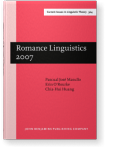Romance Paths as Cognate Complements: A Lexical-Syntactic Account
In this paper, we analyze some Path constructions that apparently go against Talmy’s (1991, 2000) typological predictions concerning Romance languages. Drawing on Hale & Keyser’s (2000) analysis of so-called ‘P-cognation’, we argue that the formation of Italian phrasal verbs (e.g., mettere giù ‘put down’ orbuttare via ‘throw away’) involves a lexical-syntactic pattern where the directional particle specifies the Path element that has already been conflated in the verb: that is, the verb itself encodes or involves a directional meaning which is further specified through a P(ath) particle. We argue that Romance languages like Italian or Catalan have verb particle constructions involving ‘P-cognation’ but lack those ones involving a lexical-syntactic subordination process whereby an independent root is merged with a null verb (e.g., John worked the night away). As predicted by Talmy’s typology, the latter are found in ‘satelliteframed languages’ like English but not in ‘verb-framed languages’ like Italian or Catalan.
Cited by (3)
Cited by three other publications
Mateu, Jaume
2023.
Parasynthesis. In
The Wiley Blackwell Companion to Morphology,
► pp. 1 ff.

Mangialavori Rasia, Eugenia
This list is based on CrossRef data as of 8 september 2024. Please note that it may not be complete. Sources presented here have been supplied by the respective publishers.
Any errors therein should be reported to them.
